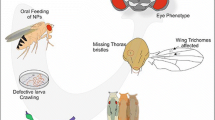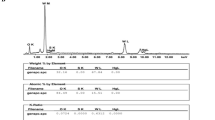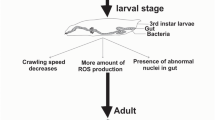Abstract
The effects of oral intake of hydroxyapatite nanoparticles (HApNPs) were investigated on growth, development and behaviour of Drosophila. The Drosophila responses to various concentrations of HApNPs were compared. At lower concentrations, i.e. 5 mg L−1 more amount of oxidative stress was produced than that of highest concentration, i.e. 80 mg L−1. The increased amounts of oxidative stress reflect a higher amount of ROS production and increased cell damage within the larval gut. HApNPs was further shown to interfere with the calcium and phosphorus absorption pathway. Besides all these damage, HApNPs causes developmental delay in the late third instar larvae. The most significant anomaly was observed in pupae count, fly hatching after the feeding of HApNPs. Flies hatched from treated vials have decreased body weight with defective walking behaviour. Hatched flies have a phenotypic defect in the wing, eye and thorax of the bristles. Along with these changes, the adult fly becomes more prone towards stress. The findings hint that HApNPs persuade noxious effects and alter the development, structure, function and behaviour of the fly in a concentration-dependent manner.

Effect of Hydroxyapatite on the complete life cycle of Drosophila. Flies lay eggs in Hydroxyapatite containing food. As soon as the eggs hatch to larvae they start eating the NP contained food. The effect of Hydroxyapatite on various developmental stage is summerised by biochemical, immunohistochemical, behavioral, developmental and phenotypic defects.








Similar content being viewed by others
References
Ahamed M, Posgai R, Gorey TJ, Nielsen M, Hussain SM, Rowe JJ (2010) Silver nanoparticles induced heat shock protein 70, oxidative stress and apoptosis in Drosophila melanogaster. Toxicol Appl Pharmacol 242(3):263–269
Alaraby M, Hernández A, Annangi B, Demir E, Bach J, Rubio L, Creus A, Marcos R (2015) Antioxidant and antigenotoxic properties of CeO2 NPs and cerium sulphate: studies with Drosophila melanogaster as a promising in vivo model. Nanotoxicology 9(6):749–759
Albanese A, Tang PS, Chan WC (2012) The effect of nanoparticle size, shape, and surface chemistry on biological systems. Annu Rev Biomed Eng 14:1–16
Ariano P, Zamburlin P, Gilardino A, Mortera R, Onida B, Tomatis M, Ghiazza M, Fubini B, Lovisolo D (2011) Interaction of spherical silica nanoparticles with neuronal cells: size-dependent toxicity and perturbation of calcium homeostasis. Small 7(6):766–774
Bhabra G, Sood A, Fisher B, Cartwright L, Saunders M, Evans WH, Surprenant A, Lopez-Castejon G, Mann S, Davis SA (2009) Nanoparticles can cause DNA damage across a cellular barrier. Nat Nanotechnol 4(12):876–883
Bose S, Saha SK (2003) Synthesis and characterization of hydroxyapatite nanopowders by emulsion technique. Chem Mater 15(23):4464–4469
Campos-Ortega JA, Hartenstein V (2013) The embryonic development of Drosophila melanogaster. Springer Science & Business Media,
Carmona ER, Escobar B, Vales G, Marcos R (2015) Genotoxic testing of titanium dioxide anatase nanoparticles using the wing-spot test and the comet assay in Drosophila. Mutation Research/Genetic Toxicology and Environmental Mutagenesis 778:12–21
de Celis JF (2003) Pattern formation in the Drosophila wing: the development of the veins. BioEssays 25(5):443–451
Chaudhry AA, Haque S, Kellici S, Boldrin P, Rehman I, Khalid FA, Darr JA (2006) Instant nano-hydroxyapatite: a continuous and rapid hydrothermal synthesis. Chem Commun 21:2286–2288
Chen Y-H, Liu H-P, Chen H-Y, Tsai F-J, Chang C-H, Lee Y-J, Lin W-Y, Chen W-C (2011) Ethylene glycol induces calcium oxalate crystal deposition in Malpighian tubules: a drosophila model for nephrolithiasis/urolithiasis. Kidney Int 80(4):369–377
Chen H, Wang B, Feng W, Du W, Ouyang H, Chai Z, Bi X (2015) Oral magnetite nanoparticles disturb the development of Drosophila melanogaster from oogenesis to adult emergence. Nanotoxicology 9(3):302–312
Chi T, Kim MS, Lang S, Bose N, Kahn A, Flechner L, Blaschko SD, Zee T, Muteliefu G, Bond N (2015) A Drosophila model identifies a critical role for zinc in mineralization for kidney stone disease. PLoS One 10(5):e0124150
Cho K, Wang X, Nie S, Chen ZG, Shin DM (2008a) Therapeutic nanoparticles for drug delivery in cancer. Clin Cancer Res 14(5):1310–1316. doi:10.1158/1078-0432.CCR-07-1441
Cho K, Wang X, Nie S, Shin DM (2008b) Therapeutic nanoparticles for drug delivery in cancer. Clin Cancer Res 14(5):1310–1316
Chu M, Wu Q, Yang H, Yuan R, Hou S, Yang Y, Zou Y, Xu S, Xu K, Ji A (2010) Transfer of quantum dots from pregnant mice to pups across the placental barrier. Small 6(5):670–678
Chyb S, Gompel N (2013) Atlas of Drosophila morphology: wild-type and classical mutants. Academic Press
Cohen CA, Karfakis JA, Kurnick MD, Rzigalinski B (2008) Cerium oxide nanoparticles reduce free radical-mediated toxicity in Drosophila melanogaster. FASEB J 22(1 Supplement):624.621–624.621
Culí J, Martín-Blanco E, Modolell J (2001) The EGF receptor and N signalling pathways act antagonistically in Drosophila mesothorax bristle patterning. Development 128(2):299–308
Demir E, Vales G, Kaya B, Creus A, Marcos R (2011) Genotoxic analysis of silver nanoparticles in Drosophila. Nanotoxicology 5(3):417–424
Dominick OS, Truman JW (1986) The physiology of wandering behaviour in Manduca sexta. III Organization of wandering behaviour in the larval nervous system Journal of experimental biology 121(1):115–132
Dorozhkin SV (2010) Nanosized and nanocrystalline calcium orthophosphates. Acta Biomater 6(3):715–734
Duer MJ, Friščić T, Proudfoot D, Reid DG, Schoppet M, Shanahan CM, Skepper JN, Wise ER (2008) Mineral surface in calcified plaque is like that of bone. Arterioscler Thromb Vasc Biol 28(11):2030–2034
Eaton S, Wepf R, Simons K (1996) Roles for Rac1 and Cdc42 in planar polarization and hair outgrowth in the wing of Drosophila. J Cell Biol 135(5):1277–1289
Evan AP (2010) Physiopathology and etiology of stone formation in the kidney and the urinary tract. Pediatr Nephrol 25(5):831–841
Evan AP, Lingeman JE, Coe FL, Worcester EM (2008) Role of interstitial apatite plaque in the pathogenesis of the common calcium oxalate stone. Semin Nephrol 28(2):111–119
Fristrom D, Wilcox M, Fristrom J (1993) The distribution of PS integrins, laminin a and F-actin during key stages in Drosophila wing development. Development 117(2):509–523
Furman D, Bukharina T (2007) Genetic control of bristle pattern formation in Drosophila melanogaster. Dokl Biol Sci 417:484–486
Georgiev P, Gerasimova T (1992) Genes involved in the development of bristles and hairs in Drosophila melanogaster. Genetica 87(1):31–35
Gorth DJ, Rand DM, Webster TJ (2011) Silver nanoparticle toxicity in Drosophila: size does matter. Int J Nanomedicine 6:343–350
Grover D, Ford D, Brown C, Hoe N, Erdem A, Tavaré S, Tower J (2009) Hydrogen peroxide stimulates activity and alters behavior in Drosophila melanogaster. PLoS One 4(10):e7580
Han X, Geller B, Moniz K, Das P, Chippindale AK, Walker VK (2014) Monitoring the developmental impact of copper and silver nanoparticle exposure in Drosophila and their microbiomes. Sci Total Environ 487:822–829
Heaney RP, Nordin B (2002) Calcium effects on phosphorus absorption: implications for the prevention and co-therapy of osteoporosis. J Am Coll Nutr 21(3):239–244
Hirata T, Cabrero P, Berkholz DS, Bondeson DP, Ritman EL, Thompson JR, Dow JA, Romero MF (2012) In vivo Drosophilia genetic model for calcium oxalate nephrolithiasis. American Journal of Physiology-Renal Physiology 303(11):F1555–F1562
Jambunathan N (2010) Determination and detection of reactive oxygen species (ROS), lipid peroxidation, and electrolyte leakage in plants. Plant stress tolerance: methods and protocols:291–297
Jiang Z, Asplin JR, Evan AP, Rajendran VM, Velazquez H, Nottoli TP, Binder HJ, Aronson PS (2006) Calcium oxalate urolithiasis in mice lacking anion transporter Slc26a6. Nat Genet 38(4):474–478
Kalita SJ, Bhardwaj A, Bhatt HA (2007) Nanocrystalline calcium phosphate ceramics in biomedical engineering. Mater Sci Eng C 27(3):441–449
Kantharia N, Naik S, Apte S, Kheur M, Kheur S, Kale B (2014) Nano-hydroxyapatite and its contemporary applications. Bone 34(15.2):1.71
Key SCS, Reaves D, Turner F, Bang JJ (2011) Impacts of silver nanoparticle ingestion on pigmentation and developmental progression in Drosophila. Atlas J Biol 1(3):52–61
Kim S, Choi JE, Choi J, Chung K-H, Park K, Yi J, Ryu D-Y (2009) Oxidative stress-dependent toxicity of silver nanoparticles in human hepatoma cells. Toxicol in Vitro 23(6):1076–1084
Kitamoto T (2001) Conditional modification of behavior in Drosophila by targeted expression of a temperature-sensitive shibire allele in defined neurons. J Neurobiol 47(2):81–92
Krebs RA, Feder ME (1997) Tissue-specific variation in Hsp70 expression and thermal damage in Drosophila melanogaster larvae. J Exp Biol 200(14):2007–2015
LeGeros R (1991) Biologically relevant calcium phosphates: preparation and characterisation, calcium phosphates in oral biology and medicine. Karger, Basel
Li N, Xia T, Nel AE (2008) The role of oxidative stress in ambient particulate matter-induced lung diseases and its implications in the toxicity of engineered nanoparticles. Free Radic Biol Med 44(9):1689–1699
Liu X, Vinson D, Abt D, Hurt RH, Rand DM (2009) Differential toxicity of carbon nanomaterials in Drosophila: larval dietary uptake is benign, but adult exposure causes locomotor impairment and mortality. Environmental science & technology 43(16):6357–6363
Ma G, Liu XY, Wang M (2011) Growth and mechanisms of enamel-like hierarchical nanostructures on single crystalline hydroxyapatite micro-ribbons. J Nanosci Nanotechnol 11(6):5199–5206
Mackay TF (1995) The genetic basis of quantitative variation: numbers of sensory bristles of Drosophila melanogaster as a model system. Trends Genet 11(12):464–470
Manke A, Wang L, Rojanasakul Y (2013) Mechanisms of nanoparticle-induced oxidative stress and toxicity. Biomed Res Int 2013:942916
Mostafa NY, Brown PW (2007) Computer simulation of stoichiometric hydroxyapatite: structure and substitutions. J Phys Chem Solids 68(3):431–437
MuÈller RH, MaÈder K, Gohla S (2000) Solid lipid nanoparticles (SLN) for controlled drug delivery—a review of the state of the art. Eur J Pharm Biopharm 50(1):161–177
Nichols CD, Becnel J, Pandey UB (2012) Methods to assay Drosophila behavior. JoVE (Journal of Visualized Experiments) 61:e3795–e3795
Ong C, Yung L-YL, Cai Y, Bay B-H, Baeg G-H (2015) Drosophila melanogaster as a model organism to study nanotoxicity. Nanotoxicology 9(3):396–403
Ong C, Lee QY, Cai Y, Liu X, Ding J, Yung L-YL, Bay B-H, Baeg G-H (2016) Silver nanoparticles disrupt germline stem cell maintenance in the Drosophila testis. Scientific reports 6
Panacek A, Prucek R, Safarova D, Dittrich M, Richtrova J, Benickova K, Zboril R, Kvitek L (2011) Acute and chronic toxicity effects of silver nanoparticles (NPs) on Drosophila melanogaster. Environmental science & technology 45(11):4974–4979
Pandey UB, Nichols CD (2011) Human disease models in Drosophila melanogaster and the role of the fly in therapeutic drug discovery. Pharmacol Rev 63(2):411–436
Pandey A, Chandra S, Chauhan LKS, Narayan G, Chowdhuri DK (2013) Cellular internalization and stress response of ingested amorphous silica nanoparticles in the midgut of Drosophila melanogaster. Biochimica et Biophysica Acta (BBA)-General Subjects 1830(1):2256–2266
Peña-Rangel MT, Rodriguez I, Riesgo-Escovar JR (2002) A misexpression study examining dorsal thorax formation in Drosophila melanogaster. Genetics 160(3):1035–1050
Pompa PP, Vecchio G, Galeone A, Brunetti V, Sabella S, Maiorano G, Falqui A, Bertoni G, Cingolani R (2011) In vivo toxicity assessment of gold nanoparticles in Drosophila melanogaster. Nano Res 4(4):405–413
Pulver SR, Pashkovski SL, Hornstein NJ, Garrity PA, Griffith LC (2009) Temporal dynamics of neuronal activation by Channelrhodopsin-2 and TRPA1 determine behavioral output in Drosophila larvae. J Neurophysiol 101(6):3075–3088
Puvvada N, Panigrahi PK, Pathak A (2010) Room temperature synthesis of highly hemocompatible hydroxyapatite, study of their physical properties and spectroscopic correlation of particle size. Nano 2(12):2631–2638
Raj A, Shah P, Agrawal N (2016) Ingestion of gold nanoparticles (AuNPs) affects survival in Drosophila in a dose-dependent manner. Int J Sci Res 5(6)
Reddy LH, Arias JL, Nicolas J, Couvreur P (2012) Magnetic nanoparticles: design and characterization, toxicity and biocompatibility, pharmaceutical and biomedical applications. Chem Rev 112(11):5818–5878
Ren N, He B, Stone D, Kirakodu S, Adler PN (2006) The shavenoid gene of Drosophila encodes a novel actin cytoskeleton interacting protein that promotes wing hair morphogenesis. Genetics 172(3):1643–1653
Riedl J, Louis M (2012) Behavioral neuroscience: crawling is a no-brainer for fruit fly larvae. Curr Biol 22(20):R867–R869
Ryall RL (2008) The future of stone research: rummagings in the attic, Randall’s plaque, nanobacteria, and lessons from phylogeny. Urol Res 36(2):77–97
Sabat D, Patnaik A, Ekka B, Dash P, Mishra M (2016) Investigation of titania nanoparticles on behaviour and mechanosensory organ of Drosophila melanogaster. Physiol Behav 167:76–85
Sabella S, Carney RP, Brunetti V, Malvindi MA, Al-Juffali N, Vecchio G, Janes SM, Bakr OM, Cingolani R, Stellacci F (2014) A general mechanism for intracellular toxicity of metal-containing nanoparticles. Nano 6(12):7052–7061
Shi Z, Huang X, Cai Y, Tang R, Yang D (2009) Size effect of hydroxyapatite nanoparticles on proliferation and apoptosis of osteoblast-like cells. Acta Biomater 5(1):338–345
Slowing II, Vivero-Escoto JL, Wu C-W, Lin VS-Y (2008) Mesoporous silica nanoparticles as controlled release drug delivery and gene transfection carriers. Adv Drug Deliv Rev 60(11):1278–1288
Sun L, Berndt CC, Gross KA, Kucuk A (2001) Material fundamentals and clinical performance of plasma-sprayed hydroxyapatite coatings: a review. J Biomed Mater Res 58(5):570–592
Vales G, Demir E, Kaya B, Creus A, Marcos R (2013) Genotoxicity of cobalt nanoparticles and ions in Drosophila. Nanotoxicology 7(4):462–468
Vecchio G, Galeone A, Brunetti V, Maiorano G, Rizzello L, Sabella S, Cingolani R, Pompa PP (2012) Mutagenic effects of gold nanoparticles induce aberrant phenotypes in Drosophila melanogaster. Nanomedicine: Nanotechnology, Biology and Medicine 8(1):1–7
Xia T, Kovochich M, Liong M, Mädler L, Gilbert B, Shi H, Yeh JI, Zink JI, Nel AE (2008) Comparison of the mechanism of toxicity of zinc oxide and cerium oxide nanoparticles based on dissolution and oxidative stress properties. ACS Nano 2(10):2121–2134
Yang Y, Oztekin A, Neti S, Mohapatra S (2012) Particle agglomeration and properties of nanofluids. J Nanopart Res 14(5):1–10
Yao J, Tjandra W, Chen YZ, Tam KC, Ma J, Soh B (2003) Hydroxyapatite nanostructure material derived using cationic surfactant as a template. J Mater Chem 13(12):3053–3057
Yuan Y, Liu C, Qian J, Wang J, Zhang Y (2010) Size-mediated cytotoxicity and apoptosis of hydroxyapatite nanoparticles in human hepatoma HepG2 cells. Biomaterials 31(4):730–740
Zhao X, Ng S, Heng BC, Guo J, Ma L, Tan TTY, Ng KW, Loo SCJ (2013a) Cytotoxicity of hydroxyapatite nanoparticles is shape and cell dependent. Arch Toxicol 87(6):1037–1052
Zhao X, Ong KJ, Ede JD, Stafford JL, Ng KW, Goss GG, Loo SCJ (2013b) Evaluating the toxicity of hydroxyapatite nanoparticles in catfish cells and zebrafish embryos. Small 9(9–10):1734–1741
Acknowledgements
S.A. Pappus is thankful to DST-Inspire fellowship for the financial support he received to carry out this work. Two anonymous reviewers are thankfully acknowledged for their valuable comments, which help to improve the manuscript.
Author information
Authors and Affiliations
Corresponding author
Ethics declarations
Conflict of interest
The authors declare that they have no conflict of interest.
Electronic supplementary material
ESM 1
(JPEG 39 kb)
Rights and permissions
About this article
Cite this article
Pappus, S.A., Ekka, B., Sahu, S. et al. A toxicity assessment of hydroxyapatite nanoparticles on development and behaviour of Drosophila melanogaster . J Nanopart Res 19, 136 (2017). https://doi.org/10.1007/s11051-017-3824-8
Received:
Accepted:
Published:
DOI: https://doi.org/10.1007/s11051-017-3824-8




